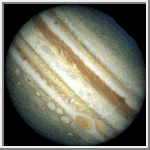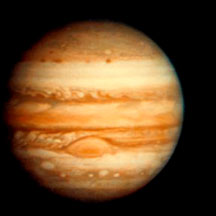

When looking at Jupiter through binoculars, it should be possible to see one or more of the Galilean moons. Discovered by Galileo in 1610 they are the four largest of Jupiter's satellites.
The smallest is Europa, which is slightly smaller than our own moon. Io is bigger than our moon and Ganymede and Callisto are both bigger than the planet Mercury. Astronomers are particularly interested in Europa because underneath it's icy surface there appears to be evidence of a warmer salty ocean. If this is the case then Europa could be our best chance of finding extra terrestrial life.

With the unaided eye Jupiter appears as a very bright star.
With binoculars it should be possible to see one or more of Jupiter's largest four moons strung out along it's axis.
Viewed through a telescope you should be able to see the equatorial belts quite clearly. All the Galilean moons can be seen (providing they are not hidden by the planet). If one of the moons is moving across the front of the planet (called a transit), this may also be visible in a small telescope.
The times of transits and the positions of the moons can be found in various astronomy magazines.
